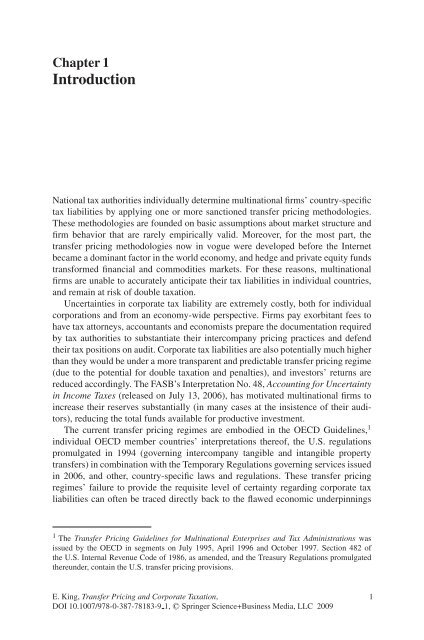Contents - AL-Tax
Contents - AL-Tax
Contents - AL-Tax
You also want an ePaper? Increase the reach of your titles
YUMPU automatically turns print PDFs into web optimized ePapers that Google loves.
Chapter 1IntroductionNational tax authorities individually determine multinational firms’ country-specifictax liabilities by applying one or more sanctioned transfer pricing methodologies.These methodologies are founded on basic assumptions about market structure andfirm behavior that are rarely empirically valid. Moreover, for the most part, thetransfer pricing methodologies now in vogue were developed before the Internetbecame a dominant factor in the world economy, and hedge and private equity fundstransformed financial and commodities markets. For these reasons, multinationalfirms are unable to accurately anticipate their tax liabilities in individual countries,and remain at risk of double taxation.Uncertainties in corporate tax liability are extremely costly, both for individualcorporations and from an economy-wide perspective. Firms pay exorbitant fees tohave tax attorneys, accountants and economists prepare the documentation requiredby tax authorities to substantiate their intercompany pricing practices and defendtheir tax positions on audit. Corporate tax liabilities are also potentially much higherthan they would be under a more transparent and predictable transfer pricing regime(due to the potential for double taxation and penalties), and investors’ returns arereduced accordingly. The FASB’s Interpretation No. 48, Accounting for Uncertaintyin Income <strong>Tax</strong>es (released on July 13, 2006), has motivated multinational firms toincrease their reserves substantially (in many cases at the insistence of their auditors),reducing the total funds available for productive investment.The current transfer pricing regimes are embodied in the OECD Guidelines, 1individual OECD member countries’ interpretations thereof, the U.S. regulationspromulgated in 1994 (governing intercompany tangible and intangible propertytransfers) in combination with the Temporary Regulations governing services issuedin 2006, and other, country-specific laws and regulations. These transfer pricingregimes’ failure to provide the requisite level of certainty regarding corporate taxliabilities can often be traced directly back to the flawed economic underpinnings1 The Transfer Pricing Guidelines for Multinational Enterprises and <strong>Tax</strong> Administrations wasissued by the OECD in segments on July 1995, April 1996 and October 1997. Section 482 ofthe U.S. Internal Revenue Code of 1986, as amended, and the Treasury Regulations promulgatedthereunder, contain the U.S. transfer pricing provisions.E. King, Transfer Pricing and Corporate <strong>Tax</strong>ation,DOI 10.1007/978-0-387-78183-9 1, C○ Springer Science+Business Media, LLC 20091
















